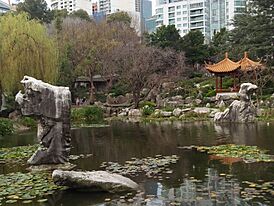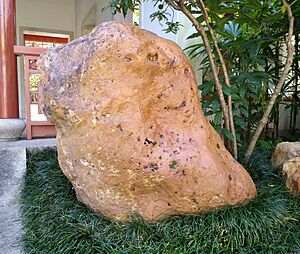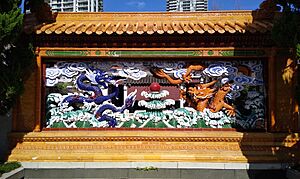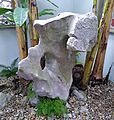Chinese Garden of Friendship facts for kids
Quick facts for kids Chinese Garden of Friendship |
|
|---|---|

Chinese Garden of Friendship
|
|
| Lua error in Module:Location_map at line 420: attempt to index field 'wikibase' (a nil value). | |
| Type | Chinese garden |
| Location | 1 Harbour Street, Sydney central business district, City of Sydney, New South Wales, Australia |
| Area | 1.03 hectares (3 acres) |
| Created | 1986–17 January 1988 |
| Designer |
|
| Operated by | Place Management NSW |
| Visitors | 230,000 (2016–17) |
| Status | Open all year |
| Official name | Chinese Garden of Friendship |
| Type | State heritage (complex / group) |
| Designated | 5 October 2018 |
| Reference no. | 2017 |
| Type | Other – Landscape – Cultural |
| Category | Landscape – Cultural |
| Builders |
|
| Chinese Garden of Friendship | |||||||||||||||||||
|---|---|---|---|---|---|---|---|---|---|---|---|---|---|---|---|---|---|---|---|
| Traditional Chinese | 誼園 | ||||||||||||||||||
| Simplified Chinese | 谊园 | ||||||||||||||||||
|
|||||||||||||||||||
The Chinese Garden of Friendship (simplified Chinese: 谊园; traditional Chinese: 誼園) is a beautiful Chinese garden in Sydney, Australia. It covers about 1 hectare (2.5 acres) and is located in the Sydney CBD. This special garden was designed to look like the classic private gardens from China's Ming dynasty. It helps visitors understand Chinese culture and history.
The garden was created by designers from Guangzhou, China, which is Sydney's sister city. It was officially opened on January 17, 1988. This was part of Sydney's big Bicentennial Celebrations. The garden was named the Chinese Garden of Friendship to show the strong bond between China and Australia. You can find it in Darling Harbour, near Sydney's Chinatown.
Contents
How Did the Chinese Garden of Friendship Start?
Before the garden was built, this area was mostly water and swamp. Later, from the 1850s to 1984, it became industrial land. Factories and workshops were here, including a company known for refrigeration. All these old buildings were removed in 1985 to make way for the new Darling Harbour area.
Building a Chinese garden on old industrial land is quite unusual. Most Chinese gardens overseas are built in existing parks. However, some gardens in Hong Kong were also built on reclaimed industrial land by the water.
Who Helped Create the Garden?
Many people helped make the garden a reality. Henry Tsang, an important leader in Sydney's Chinese community, had wanted a Chinese garden in Sydney since the 1970s. He saw other Chinese gardens being built in places like Hong Kong and Singapore.
When the Darling Harbour area was being redeveloped in 1984, the local Chinese community asked the New South Wales (NSW) government for a space. Mr. Tsang spoke to Neville Wran, who was the leader of NSW at the time. He asked for land to build a traditional Chinese garden. This garden would celebrate the Chinese community's role in Australia's history.
Mr. Tsang and the community got a spot near Chinatown. They also helped create a partnership between the Guangdong Province in China and the State of New South Wales. Both governments agreed to help pay for, design, and build the new garden.
A Special Partnership
The agreement said that Guangdong would provide the garden's design. They would also send important building materials, furniture, and artworks from China. New South Wales would manage and pay for the construction through the Darling Harbour Authority.
Building the garden had its challenges. They had to turn Chinese design drawings into Australian building plans. It was hard to find local workers with the right skills for the unique Chinese building methods. They also needed to find suitable local materials and import special items from China. These included artworks, furniture, tiles, and special rocks.
The Chinese Garden of Friendship officially opened in 1988. This was during Australia's Bicentennial celebrations, which focused on Australia being a multicultural country. It was the first Chinese garden of its kind in the Southern Hemisphere. It was also one of the first in the world outside of China.
In 2018, the garden celebrated its 30th anniversary. It continues to be a special place for the community. On October 4, 2018, the garden was added to the New South Wales State Heritage Register. This means it is a very important historical site.
What Does the Garden Look Like?
The Chinese Garden of Friendship is a specially designed landscape. It is mostly surrounded by a tall wall. The garden has three main parts:
- Garden areas with plants and pathways.
- A lake and streams.
- Pavilions and other buildings.
Outside the main garden, there are steps leading to the entrance. You'll see two large imperial guardian lion statues, one male and one female. These statues protect the entrance.
The garden's design is based on a "scholar's garden" or "classical garden." These gardens were places for quiet thought, poetry, art, and enjoying nature.
How is the Garden Designed?
The garden's design uses special principles to create good energy, known as qi (pronounced "chee").
- It has a large central lake to gather positive energy, which can mean wealth and good fortune.
- Landforms are placed to block bad weather and let in the sun.
- Pavilions are built around the water to reflect and spread the good energy.
- There are important views between the main pavilions and the landscape.
A study in 2004 found that the garden truly shows these design ideas. It also represents the five elements: water, earth, air, wood, and metal.
The garden combines Chinese and Sydney styles, materials, and building skills. The plants in the garden have changed over time. When it first opened, many plants were put in, expecting some to die. But the garden grew well, and some plants have been removed to give others space.
Like any living garden, it is always changing. The garden is carefully looked after to keep its original design and spirit. It also adapts to changes in weather and how people use it.
The Garden Wall
The garden is surrounded by a white wall on three sides. This wall is about 4 meters (13 feet) tall and has special terracotta tiles on top. The western side has a different fence. This fence lets people outside see into the garden, which encourages them to visit. This "open" fence also helps the qi energy flow from the garden towards Cockle Bay.
Entrance Area
At the garden entrance, there are steps and platforms. You'll see two large imperial guardian lion statues, also called shi statues. These protect the entrance. Some ceramic trays and special stones at the entrance are from Guangdong, China.
Pavilions
There are 17 pavilions in the garden. Some are connected, and others stand alone. They are built using parts from both China and Australia.
- Grey roof tiles and golden glazed roofs are from Guangdong.
- Granite paving and handrails are also from Guangdong.
- Grey bricks, recycled from old buildings in Guangdong, were polished in China.
- Grey floor tiles and ceramic window frames are from Shanghai.
- Granite columns and door frames are from Fujian, China.
- Timber patterns and other wooden parts are from New South Wales.
Pavilion Artworks and Furniture
All the art, including calligraphy, wall hangings, and paintings, were gifts from the government of Guangdong. The traditional furniture pieces were also gifts from Guangdong. A newer display cabinet in the Water Pavilion was made in New South Wales.
Water Features
The lake, pond, and streams have a concrete base. The waterfall rocks are made using a special spraying technique, similar to what you might see at Taronga Zoo. The water is cleaned and recycled, just like in a public fountain.
Garden Rocks
Most of the rocks in the garden come from an ancient river bed in New South Wales. In China, water-worn rocks were highly valued in gardens. This shows how local materials were used in a traditional Chinese way.
Stone Bridges
All the stone bridges in the garden are made of granite from Guangdong, China.
Special Rock Sculptures
- Ying rocks in the Courtyard of Welcoming Fragrance are weathered limestone from Yingde, China.
- A Taihui rock in the Hall of Longevity garden is a rare weathered limestone from Lake Tai in China. It was a gift from Guangdong.
- A Wax rock in the Hall of Longevity courtyard is a rare river-shaped rock, also a gift from Guangdong.
The Dragon Wall
The Dragon Wall is a special screen made of glazed terracotta from China. It was made just for this garden and was a gift from Guangdong. The wall shows a blue dragon for New South Wales and a brown dragon for Guangdong. Both dragons are looking for the pearl of wisdom. The design is based on famous "nine dragon walls" in China. Chinese potters assembled the wall on site from 943 pieces.
The Main Gate
The main gate, also called the Mountain Gate, was a gift from the government of Guangdong.
Garden Paths
All the paving, including paths with pebble designs, were made by contractors from New South Wales. The pebble patterns are decorative and look like natural stones found near lakes and rivers.
Plants
All the plants in the garden were found in New South Wales. This includes both Australian plants and plants from other countries. There are two lychee trees that were planted by visiting governors from Guangdong province. Lychee is one of the "four great fruits of Lingnan" in China.
Penjing Collection
Penjing (Chinese: 盆景) means "landscapes in a tray" or "tray scenery." It's about creating tiny landscapes with trees and rocks. Sometimes, small figures or bridges are added. The garden's collection started in 1992. Most of it is in the Cantonese or Lingnan style, which is from Guangdong and Guangxi provinces. This style focuses on matching the plants and pots perfectly.
The collection has 17 individual penjing, made from 13 different plant types. This includes two Port Jackson fig trees, which are native to Australia. Some of the penjing are very old, up to 70 years. All of them were grown and styled by penjing artists in Sydney. Some of the ceramic trays and stones for the penjing are from Guangdong.
Garden Condition and Changes
The garden is in very good condition and has not changed much since it was built. The plants have grown a lot since 1988. Sometimes, plants have been removed to keep the important views clear.
Over time, some parts of the garden have been updated:
- In 2005, the Blue Room, which was a cafe, became a meeting room. It is not open to the public anymore.
- The original gift shop was turned into the current cafe. A small courtyard where the penjing collection was first displayed was removed to build a new kitchen. The penjing collection was moved to the Courtyard of Welcoming Fragrance.
- The entrance area was changed to add a ramp for people with disabilities. It was also made larger to give the entrance more presence.
- In 2013, the public toilets were renovated inside.
The pavilions are still in their original condition, with regular painting and small repairs.
In Popular Culture
The Chinese Garden of Friendship has been used in movies!
- It was a setting for Dulcea's compound in the 1995 superhero film Mighty Morphin Power Rangers: The Movie.
- It was also used in the filming of The Wolverine in October 2012. For this movie, many parts of the garden were changed or covered up to make it look like Japan. All Chinese writing and dragon designs were removed, and a temporary pavilion was built in the middle of the lake.
Why is the Garden Important?
The Chinese Garden of Friendship is very important to New South Wales. It's a great example of a Chinese garden built with the help of the community. It was the first garden of its kind in NSW, created together by Sydney's Chinese communities and governments from NSW and Guangdong.
The garden shows over a thousand years of Chinese garden design traditions. It blends Chinese culture with Sydney's urban setting. Its penjing collection, grown in Sydney, uses both Australian plants like the Port Jackson fig and plants from China. The garden also has special wooden screens and open pavilions that look like older Sydney designs. This mix helped people in Sydney feel familiar with Chinese gardens.
The garden connects the large Darling Harbour area with the smaller, more personal streets of Chinatown. It shows how Sydney's Chinese communities continue to grow. The garden uses both Chinese design and craftsmanship, along with materials and building methods from Sydney and NSW. It is a unique example of how different cultures can work together to create something beautiful.
The garden symbolizes how Australian-Chinese communities are welcomed into society. It shows the successful teamwork between Chinese and Sydney designers, builders, and artists. It's a special example of cultural exchange, bringing the rich heritage of Guangdong and Southern China to a new garden that everyone can enjoy.
The Chinese Garden of Friendship was added to the New South Wales State Heritage Register on October 5, 2018, because it is important for several reasons:
- It shows the history and culture of New South Wales.
- It has beautiful design and shows great creative skill.
- It has a strong connection with the Chinese community in New South Wales.
- It is a unique example of cultural history in New South Wales.
Gallery
Images for kids
See also
 In Spanish: Jardín chino de la Amistad para niños
In Spanish: Jardín chino de la Amistad para niños









